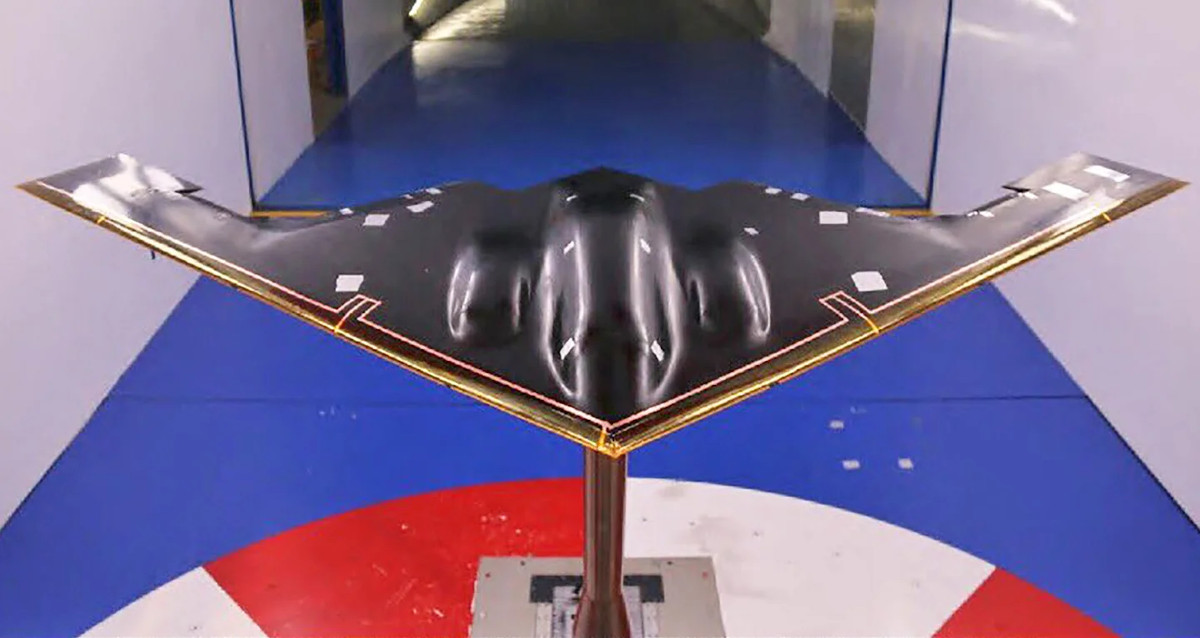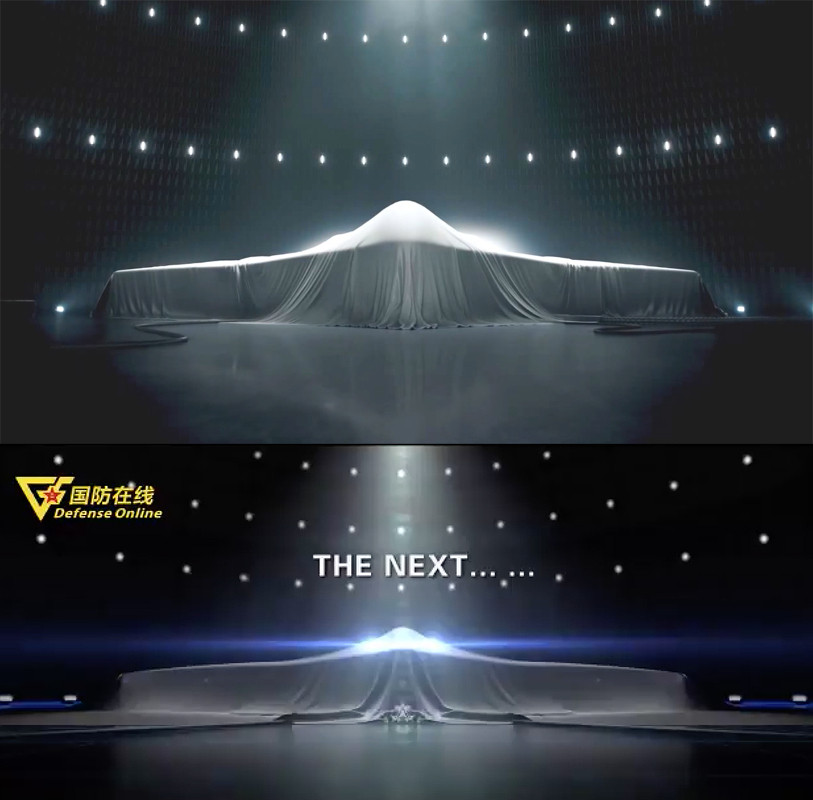A new, slickly-produced recruitment video for China’s People’s Liberation Army Air Force, or PLAAF, closes with the first official rendering of any kind of the long-rumored H-20 stealth bomber. What we see shows a distinct resemblance to the U.S. Air Force’s B-2 Spirit and the future B-21 Raider, but we don’t know how much this depiction reflects the details of the actual design.
The PLAAF recruiting video first appeared on YouTube on January 5, 2021, and looks to be legitimate. A notice underneath says “CCTV [China Central Television] is funded in whole or in part by the Chinese government.”
Titled “Dream of Youth,” it presents a narrative that follows a single individual as they join China’s air force and become a fighter pilot. At its end, the video takes the viewer into a computer-rendered futuristic-looking hangar containing the stealth bomber, which is first seen under a sheet. This is similar to what we saw in another glitzy video that the state-run Aviation Industry Corporation of China (AVIC) released in 2018, which also aped a famous Northrop Grumman Superbowl ad that had teased the aircraft that became known as the B-21. In a reflection on the visor of a helmet, we then see the sheet being pulled off, revealing the front end of the aircraft.

The rest of the video includes a mixture of real footage and renderings of various Chinese fighter jets, focusing heavily on the stealthy J-20. There is one computer-generated segment where one of those stealth fighters flies alongside a formation of early Cold War MiG-15s with North Korean People’s Army markings, a nod to the participation of PLAAF pilots in the Korean War, a formative moment in the service’s early history.

The obvious star of the video is this rendering of the flying-wing type aircraft at the end. Details about the H-20 stealth bomber remain scant, but it has been widely believed to have this type of general planform.
The Xi’an Aircraft Industrial Corporation (XAC), the division of AVIC focused on the development of larger aircraft, including China’s H-6 family of derivatives of the Soviet Tu-16 Badger bomber and the Y-20 airlifter, is reportedly overseeing the H-20 program. Work on that aircraft is said to trace back to at least the early 2000s and the basic design is reported to have been largely frozen by 2011. There have also been reports that XAC may have slowed work on the H-20 to focus on finishing development and then ramping up production of the Y-20.
What is shown of the front end of the aircraft in the PLAAF recruitment video has clear similarities to the shape of both the B-2 and a similar rendering of the B-21. The contours of the aircraft that are seen when it is still covered by the sheet also show a cockpit flanked by two air intakes, which is reminiscent of those two Northrop Grumman designs.

China has certainly very-closely investigated the B-2 design as part of various projects in the past. Photographs of an apparent Chinese B-2 wind tunnel model have been circulating online, which the War Zone
has analyzed in-depth in the past, but these are not thought to be directly related to the H-20 program.
As The War Zone‘s own Tyler Rogoway wrote while discussing that wind tunnel model:
Copying the B-2 exactly to create the H-20 seems a bit odd, even for China, as well. Better low observable capabilities, higher altitude performance, and a simplified empennage design could be had by not including its saw-tooth trailing edge. This was added midway through the B-2’s development at great cost to allow the aircraft to penetrate at low altitudes. You can read all about this design change and how the original B-2 planform design will likely mirror that of the B-21 Raider in this past special feature of ours.

Without seeing anything of the rear of the computer-rendered design in the new video, it’s impossible to make any new assessment about the H-20’s possible planform in this regard. Even if we did have a full view, it is again worth noting that what we’re seeing here is only a rendering and is likely not necessarily an accurate representation of the final design.
Regardless, the rendering is still notable since this is the first official depiction of the H-20 of any kind. In addition, it follows multiple reports in recent years from Chinese media that a possible public reveal of this bomber might be coming in the near-term, as well as the earlier teasing of its design in the 2018 AVIC video.

In the meantime, the PLAAF, as well as the People’s Liberation Army Navy, have been actively demonstrating greater competence in longer-range bomber operations, including in exercises together with Russian bombers and from outposts in the contested South China Sea, using new derivatives of the H-6. This includes the still relatively young H-6N, which is designed to carry air-launched ballistic missiles, including ones that might be tipped with hypersonic boost-glide vehicles, and other outsized payloads, such as large high-speed drones, under its fuselage.
However, the underlying H-6 design is dated and can only be expanded upon so much, inherently limiting its utility as a long-range strategic platform, especially in the nuclear deterrent role. Existing reporting suggests that the H-20 will be able to carry 10 tons of munitions and have a maximum unrefueled range of around 5,000 miles, giving it substantially greater reach than any H-6 variant, especially if also armed with long-range land-attack cruise missiles.
The H-20 could also provide a valuable long-range conventional weapons truck of sorts for the PLAAF that has the ability to penetrate deeper into hostile territory to strike critical targets, such as command and control and air defense nodes, as well as airfields and other important infrastructure. This could all help pave the way for follow-on strikes by non-stealthy aircraft, as well.
This kind of capability would present significant new challenges for China’s opponents, including major potential adversaries, such as the United States and India, across the Asia-Pacific region. Modernized H-6s toting very-long-range standoff weapons and a possible future stealthy medium bomber, the latter of which you can read more about in this past War Zone piece, could also complement the H-20s to provide a very capable and flexible array of extended-range aerial strike options. The H-20 could also springboard a new robust leg of the Chinese nuclear deterrent, putting even the U.S. at risk.

Introducing a stealth bomber would also be well in line with the PLA’s wide array of other high-tech modernization efforts, including stealthy UCAVs, increasingly more capable drone swarms, hypersonic and anti-satellite weapons, electromagnetic railguns, and more. No matter what, while we have no way of knowing if this video indicates that the actual H-20 — whatever it might be look like in the end — is getting close to breaking cover, it is yet another hint that work on that aircraft is making significant progress.
Contact the author: joe@thedrive.com
